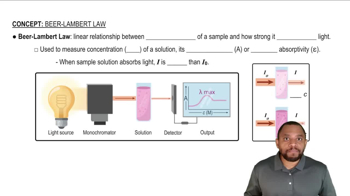Here are the essential concepts you must grasp in order to answer the question correctly.
Specific Rotation
Specific rotation is a property of chiral compounds that quantifies their ability to rotate plane-polarized light. It is defined as the observed rotation of light (in degrees) divided by the concentration of the solution (in grams per milliliter) and the path length of the polarimeter tube (in decimeters). This value is crucial for characterizing and comparing the optical activity of different substances.
Recommended video:
Specific rotation vs. observed rotation.
Polarimetry
Polarimetry is an analytical technique used to measure the angle of rotation of polarized light as it passes through a sample. The degree of rotation is influenced by the sample's concentration, the length of the path through which the light travels, and the specific rotation of the substance. Understanding polarimetry is essential for accurately determining the specific rotation of chiral compounds.
Concentration and Dilution
Concentration refers to the amount of solute present in a given volume of solution, typically expressed in grams per milliliter (g/mL). In this context, dilution occurs when a concentrated solution is mixed with a solvent, affecting the overall concentration. Calculating the specific rotation requires knowing the concentration of the sample in the polarimeter tube, which is derived from the initial concentration and the volume of the diluted solution.
Recommended video:
The Beer-Lambert Law Concept 1
 Verified step by step guidance
Verified step by step guidance Verified Solution
Verified Solution


 5:43m
5:43m